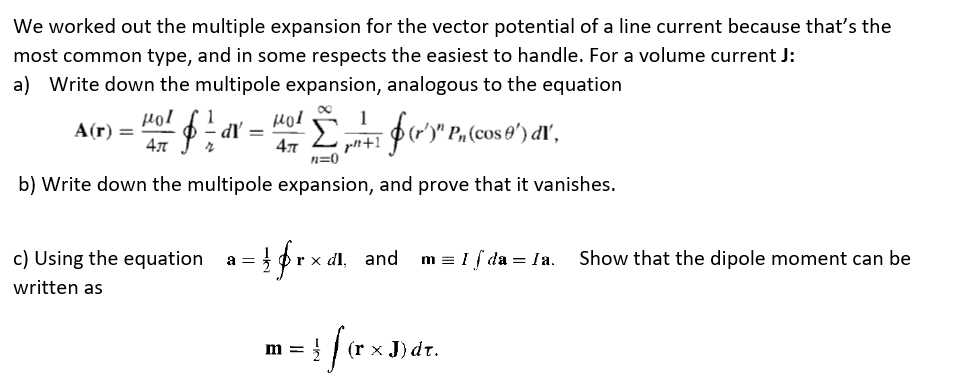We worked out the multiple expansion for the vector potential of a line current because that's the most common type, and in some respects the easiest to handle. For a volume current J: a) Write down the multipole expansion, analogous to the equation µol A(r) = 4л 1 dľ = 1 for. ' Pn (cos 0') dľ', L pn+1 47 n=0 b) Write down the multipole expansion, and prove that it vanishes. c) Using the equation a = r x dl, and m = I i da = la. Show that the dipole moment can be written as m = (r x J) dt.
We worked out the multiple expansion for the vector potential of a line current because that's the most common type, and in some respects the easiest to handle. For a volume current J: a) Write down the multipole expansion, analogous to the equation µol A(r) = 4л 1 dľ = 1 for. ' Pn (cos 0') dľ', L pn+1 47 n=0 b) Write down the multipole expansion, and prove that it vanishes. c) Using the equation a = r x dl, and m = I i da = la. Show that the dipole moment can be written as m = (r x J) dt.
Related questions
Question
100%

Transcribed Image Text:We worked out the multiple expansion for the vector potential of a line current because that's the
most common type, and in some respects the easiest to handle. For a volume current J:
a) Write down the multipole expansion, analogous to the equation
µol
A(r) =
4л
1
dľ =
1
for.
' Pn (cos 0') dľ',
L pn+1
47
n=0
b) Write down the multipole expansion, and prove that it vanishes.
c) Using the equation
a =
r x dl, and
m = I i da = la.
Show that the dipole moment can be
written as
m =
(r x J) dt.
Expert Solution
This question has been solved!
Explore an expertly crafted, step-by-step solution for a thorough understanding of key concepts.
This is a popular solution!
Trending now
This is a popular solution!
Step by step
Solved in 3 steps with 3 images
